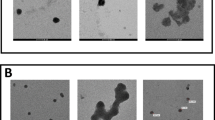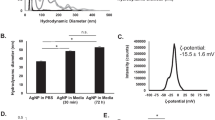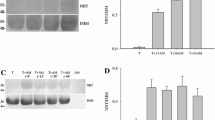Abstract
Exposure of 3T3 cells to micromolar doses of 1-chloro-2,4-dinitrobenzene, a substrate for glutathione-S-transferase, resulted in a rapid depletion of total cellular glutathione accompanied by disassembly of microtubules as visualized by fluorescence microscopy. However, prolonged incubation resulted in cellular recovery from 1-chloro-2,4-dinitrobenzene insult as evidenced by a steady rise in total cellular glutathione accompanied by microtubule reassembly to their normal organization 5 hours after treatment. To evaluate the role of total cellular glutathione in modulating the 1chloro-2,4-dinitrobenzene-induced cytoskeletal perturbation, we used 1-chloro-2,4-dinitrobenzene and/or buthiomine sulfoximine, an effective irreversible inhibitor of glutathione synthesis, to manipulate cellular glutathione levels. Incubation of 3T3 cells with 2.5 μM 1-chloro-2,4-dinitrobenzene and 250 μM buthiomine sulfoximine for 5 hours resulted in a complete depletion of total cellular glutathione accompanied by essentially complete loss of microtubules and marked alterations in the density and distribution pattern of microfilaments. Buthionine sulfoximine enhanced markedly the extent and duration of cellular glutathione depletion and the severity of microtubule disruption of 3T3 cells over the level achieved by 1-chloro-2,4-dinitrobenzene treatment alone. Furthermore, buthiomine sulfoximine also prevented the restoration of cellular glutathione content and microtubule reassembly that normally were evident 5 hours after 1-chloro-2,4-dinitrobenzene treatment. Exposure of 3T3 cells to 50 μM 2-cyclohexene-l-one, which depletes free glutathione by conjugation, resulted in a com
Similar content being viewed by others
Abbreviations
- BSO:
-
DL-buthiomine-S-R-sulfoximine
- CDNB:
-
1-chloro-2,4-dinitrobenzene
- CHX:
-
2-cyclohexene-l-one
- GSH:
-
glutathione
- GST:
-
glutathione-S-transferase
- MAPS:
-
microtubule-associated proteins
- MF:
-
microfilaments
- MT:
-
microtubules.
References
ARRICK, B.A., NATHAN, C.F., GRIFFITH, O.W. and COHN, Z.A. (1982). Glutathione depletion sensitizes tumor cells to oxidative cytolysis. J. Biol. Chem. 257:1231–1237.
BOCK, F.G., FJELDE, A., FOX, H.W. and KLEIN, E. (1969). Tumor promotion by 1-fluoro-2,4-dinitrobenzene, a potent skin sensitizer. Cancer Res. 27:179–182.
BOYLAND, E. and CHASSEAUD, L.F. (1969). The role of glutathione and glutathione S-transferases in mercapturic acid biosynthesis. Advan. Enzymol. 32:172–219.
BURCHILL, B.R., OLIVER, J.M., PEARSON, C.B., LEINBACH, E.D. and BERLIN, R.D. (1978). Microtubule dynamics and glutathione metabolism in phagocytizing human polymorphonuclear leukocytes. J. Cell Biol. 76:439–447.
CHOU, I.N. and SHAW, J.P. (1984). Microtubule disassembly and morphologic alterations induced by 1-chloro-2,4-dinitrobenzene, a substrate for glutathione S-transferase. Cell Biol. Int. Rep. 8:441–448.
CLARKSON, T.W., SAGER, P. R. and SYVERSEN, L.M. (1984). Structure and function of the cytoskeleton. In: The Cytoskeleton: A Target for Toxic Agents (T.W. Clarkson, P.R. Sager and L.M. Syversen, eds.), pp. 1–21. Plenum Press, New York.
FISCHMAN, C.M., UDEY, M.C., KURTZ, M. and WENDNER, H.J. (1981). Inhibition of lectin-induced lymphocyte activation by 2-cyclohexene-l-one: decreased intracellular glutathione inhibits an early event in the activation sequence. J. Immunol. 127:2257–2262.
FULTON, A. (1984). The cytoskeleton: cellular architecture and choreography. Chapman and Hall, New York.
GRIFFITH, L.M. and POLLARD, T.D. (1982). The interaction of actin filaments with microtubules and microtubule-associated proteins. J. Biol. Chem. 257:9143–9151.
GRIFFITH, O.W. and MEISTER, A. (1979). Potent and specific inhibition of glutathione synthesis by buthionine sulfoximine (S-n-butyl homocysteine sulfoximine). J. Biol. Chem. 254:7558–7560.
HABIG, W.H., PABST, M.J. and JAKOBY, W.B. (1974). Glutathione S-transferase: the first enzymatic step in mercapturic acid formation. J. Biol. Chem. 249:7130–7139.
HINSHAW, D.B., SKLAR, L.A., BOHL, B., SCHRAUFSTATTER, I.U., ROSSI, M.W., SPRAGG, R.G. and COCHRANE, C.G. (1986). Cytoskeletal and morphologic impact of cellular oxidant injury. Am. J. Pathol. 123:454–464.
HUEBNER, E. and GUTZEIT, H. (1986). Nurse cell-oocyte interaction: a new F-actin mesh associated with the microtubule-rich core of an insect ovariole. Tissue Cell 18:753–764.
IGWE, O.J. (1986). Biologically active intermediates generated by the reduced glutathione conjugation pathway. Biochem. Pharmacol. 35:2987–2994.
IKEDA, Y. and STEINER, M. (1978). Sulfhydryls of platelet tubulin: their role in polymerization and colchicine binding. Biochem. 17:3454–3459.
KANG, Y.-J. and ENGER, M.D. (1987). Effect of cellular glutathione depletion on cadmium induced cytotoxicity in human lung carcinoma cells. Cell Biol. Toxicol. 3:347–360.
KETTERER, B., COLES, B. and Meyer, D.J. (1983). The role of glutathione in detoxification. Environ. Health Perspect. 49:59–69.
KRAHUS, E., LITTLE, M., KEMPF, T., HOFERWARBINEK, R., ADE, W. and PONSTINGL, H. (1981). Complete amino acid sequence of β-tubulin from porcine brain. Proc. Natl. Acad. Sci. USA 78:4156–4160.
KURIYAMA, R. and SAKAI, H. (1974). Role of tubulin -SH groups in polymerization to microtubules. J. Biochem. 76:651–654.
LEE, Y.C., YAPLE, R.A., BALDRIDGE, R., KIRSCH, M. and HIMES, R.H. (1981). Inhibition of tubulin self-assembly in vitro by fluorodinitrobenzene. Biochim. Biophys. Acta 671:71–77.
MEISTER, A. (1984). New aspects of glutathione biochemistry and transport: selective alternation of glutathione metabolism. Fed. Proc. 43:3031–3042.
MELLON, M.G. and REBHUN, L.I. (1976). Sulfhydryls and the in vitro polymerization of tubulin. J Cell Biol. 70:226–238.
PAPASOZOMENOS, S.C. and PAYNE, M.R. (1986). Actin immunoreactivity localizes with segregated microtubules and membranous organelles and in the subaxolemmal region in the β,β′-iminodipropionitrile axon. J. Neurosci. 6:3483–3491.
PERRINO, B.A. and CHOU, I.N. (1986). Role of calmodulin in cadmium-induced microtubule disassembly. Cell Biol. Int. Rep. 10:565–573.
PONSTINGL, H., KRAUHS, E., LITTLE, M. and KEMPF, T. (1981). Complete amino acid sequence of α-tubulin from porcine brain. Proc. Natl. Acad. Sci. USA 78:2757–2761.
SATTILARO, R.F., DENTLER, W.L. and LECLUYSE, E.L.(1981). Microtubuleassociated proteins (MAPs) and the organization of actin filaments in vitro. J. Cell Biol. 90:467–473.
SCHRODER, E.W., CHOU, I.N. and BLACK, P.H. (1980). Effects of retinoic acid on plasminogen activator and mitogenic response of cultured mouse cells. Cancer. Res. 40:3089–3094.
SHAW, J.P. and CHOU, I.N. (1986). Elevation of intracellular glutathione content associated with mitogenic stimulation of quiescent fibroblasts. J. Cell. Physiol. 129:193–198.
SOLOMON, F., MAGENDANTZ, M. and SALZMAN, A. (1979). Identification with cellular microtubules of one of the co-assembling microtubule-associated proteins. Cell 18:431–438.
TIETZE, F. Enzymic method for quantitative determination of nanogram amounts of total and oxidized glutathione: applications to mammalian blood and other tissues. Anal. Chem. 27:502–522.
WANG, K., FERAMISCO, J.R. and ASH, J.F. (1982). Fluorescent localization of contractile proteins in tissue culture cells. Methods Enzymol. 85:514–562.
WARREN, S.T., DOLITTLE, D.J., CHANG, C., GOODMAN, J.I. and TROSKO, J.E. (1982). Evaluation of the carcinogenic potential of 2,4-dinitrofluorobenzene and its implications regarding mutagenicity testing. Carcinogenesis 3:139–145.
WOOD, J.L. (1970). Biochemistry of mercapturic acid formation. In: Metabolic Conjugation and Metabolic Hydrolysis (W. H. Fishman, ed.), Vol. 2, pp. 261–299. Academic Press, New York.
Zhao, Y., LI, W. and CHOU, I.N. (1987). Cytoskeletal perturbation induced by herbicides, 2,4-dichlorophenoxyacetic acid (2,4-D) and 2,4,5-trichlorophenoxyacetic acid (2,4,5-T). J. Toxicol. Environ. Health. 20:11–26.
Author information
Authors and Affiliations
Rights and permissions
About this article
Cite this article
Leung, MF., Chou, IN. Relationship between 1-chloro2,4-dinitrobenzene-induced cytoskeletal perturbations and cellular glutathione. Cell Biol Toxicol 5, 51–66 (1989). https://doi.org/10.1007/BF00141064
Received:
Accepted:
Issue Date:
DOI: https://doi.org/10.1007/BF00141064




